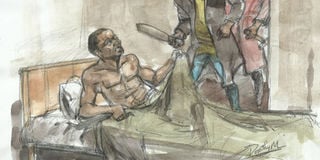Kiruhura murders; the forensic evidence

Physical evidence
Physical evidence includes trace evidence, material transferred from one object to another.
The importance of trace evidence was stated by Edmond Locard (1877-1966), a French forensic scientist, in what is now known as Lorard’s principle, which states; “Wherever he steps, whatever he touches, whatever he leaves, even unconsciously, will serve as a silent witness against him. Not only his fingerprints, but his hair, the fibres of his clothes, the glass he breaks, the tool mark he leaves, the paint he scratches, the blood or semen he deposits or collects.
All these and more, bear mute witness against him. This is evidence that does not forget. It is not confused by the excitement of the moment. It is not absent because human witnesses are. It is factual evidence. Physical evidence cannot be wrong, it cannot perjure itself, it cannot be wholly absent. Only human failure to find it, study and understand it, can diminish its value.”
Trace evidence
Trace evidence is also known as fragmentary evidence. When a crime is committed, trace evidence needs to be collected from the scene. Ideally a team of specialised police officers, also known as scenes of crime officers, go to the scene of crime and seal it off. They record videos from the scene and take photographs of the scene, victim or victims and items of value as evidence. They look for foot, shoe, and tire mark impressions, plus hair as well as examine any vehicles including looking for fingerprints.
Evidence
On 17th August 2013, a team of police officers visited the scene of crime where Daniel Karuhanga and five of his workers were murdered in Kiruhura District. A post-mortem examination carried out on the bodies established that the deceased had died as a result of cuts in the neck and head. A student, then 17 years old had also been sexually violated that night and the family car stolen.
A Primary Three pupil, then 10 years old, witnessed the murder of two of the deceased. The boy was the son of Karuhanga’s younger wife but from an earlier relationship.
He told court that he was woken from sleep when the assailant opened the door of the room they were sleeping in.
The assailant ordered him to cover himself with blanket and then proceeded to cut the two workers with a machete. The witness further told court that one of the victims did not wake up and did not make any noise when he was killed. He further described the assailant as “not short and not tall and wearing a jacket” although he admits that he did not see the man’s face. The boy corroborated what other witnesses had stated earlier; that the assailant had a hammer, machete and a torch.
Crime scene
Among the first officers to arrive at the home of the late Karuhanga after the murders was a scene of crime officer who came with a special kit. The officer had worked as a crime scene officer for six years. He took photographs of the bodies and recovered exhibits thought to be of value. These included a machete apparently stained with blood, a hammer also thought to be blood stained, two spears, a single gumboot, and swabs for blood from each dead body.
The officer, however, confessed that he failed to lift finger or footprints from the scene. He duly marked the exhibits and kept the exhibits for about three weeks and handed them over to a senior officer, three weeks later.
The officer, during cross-examination, admitted that he observed blood on the floor of the room where Karuhanga was killed but did not notice if the walls had blood on them. He told court that in the second room he examined, there was no blood on the walls. The officer also told court that it had rained the previous night and the ground was rather wet on the morning he carried out his examinations.
Testimony
The Regional Criminal Investigation Officer testified that she carried out a search at the home of Jovia Karuhanga, the first wife of Daniel but did not recover anything of evidential value. It was only five weeks later that she recovered a black gumboot and other items from the home of one of the suspects. She did not remember any distinguishing features that the gumboot bore.
The Kiruhura murders were regarded as high profile and in September 2013 a team from the Special Investigation Unit of the Police was tasked to review the investigations into the case and come out with a work plan.
On September 8, 2013, three weeks after the murders, the team visited and attempted to reconstruct the scene of crime and picked other possible exhibits. On one of the doors was a shoe impression with what was suspected to contain soil. A police officer used a razor blade to scrap the soil sample.
The team followed the track taken by the police dogs that had carried out the initial tracking and they found gumboot impressions in the home of Jovia Karuhanga, from which they also picked soil samples. The team further recovered a metallic part of a hammer that was thought to have been blood stained. This team picked the earlier exhibits collected and submitted all of them to the Government Analytical Laboratory for analysis.
Next; Analysis of the forensic evidence
To be continued



